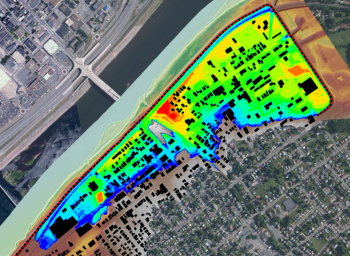Consequence Analysis: Difference between revisions
No edit summary |
No edit summary |
||
| Line 1: | Line 1: | ||
__NOTOC__ | __NOTOC__ | ||
<!-- Delete any sections that are not necessary to your topic. Add pictures/sections as needed --> | |||
__NOTOC__ | |||
---- | |||
{{Picture | |||
<!-- Add image file name (ex.image.jpg) --> | |||
|image=breach1.png | |||
<!--Add link if applicable --> | |||
|link= | |||
<!-- Add picture caption --> | |||
|caption=2D hydraulic modeling can be used to simulate and estimate the consequences of dam and levee failures. | |||
}} | |||
---- | ---- | ||
<!-- Delete any sections that are not necessary to your topic. Add pictures/sections as needed --> | <!-- Delete any sections that are not necessary to your topic. Add pictures/sections as needed --> | ||
| Line 12: | Line 24: | ||
“Developing the inventory of assets involves researching such features as the number of occupants, number of jobs created by the asset, cost of replacement, and contents value. If an EAP has been developed, it may contain valuable information that can be used throughout the analysis. For this and subsequent steps in the assessment of consequences, involving a variety of stakeholders with local knowledge of the inundation area, the local economy, and the area surrounding the inundation area is necessary to determine whether the assessment is complete and justifiable, and whether the assumptions are reasonable”. <ref name ="FEMA 2012"></ref> | “Developing the inventory of assets involves researching such features as the number of occupants, number of jobs created by the asset, cost of replacement, and contents value. If an EAP has been developed, it may contain valuable information that can be used throughout the analysis. For this and subsequent steps in the assessment of consequences, involving a variety of stakeholders with local knowledge of the inundation area, the local economy, and the area surrounding the inundation area is necessary to determine whether the assessment is complete and justifiable, and whether the assumptions are reasonable”. <ref name ="FEMA 2012"></ref> | ||
==Best Practices Resources== | ==Best Practices Resources== | ||
{{Document Icon}} [[Downstream Hazard Classification Guidelines (ACER TM 11)|Downstream Hazard Classification Guidelines (ACER TM 11) (Bureau of Reclamation)]] | {{Document Icon}} [[Downstream Hazard Classification Guidelines (ACER TM 11)|Downstream Hazard Classification Guidelines (ACER TM 11) (Bureau of Reclamation)]] | ||
Revision as of 04:34, 17 September 2022

|
| 2D hydraulic modeling can be used to simulate and estimate the consequences of dam and levee failures. |
“Adverse Consequences: Negative impacts that may result from the failure of the dam. The primary concerns are loss of human life, economic loss (including property damage), lifeline disruption, and environmental impact”. “Hazard Potential: The possible adverse incremental consequences that result from the release of water or stored contents due to failure of the dam or mis-operation of the dam or appurtenances”. [1].
“The consequence assessment begins by gathering information about the dam and determining the dam failure scenario that will be the basis of the assessment. Depending on the resources available, several types of dam failure scenarios may be considered”. [2].
“After determining the specific dam characteristics, the inundation area should be defined. The inundation area is the total flooded area that would result from dam failure. The inundation area may be localized or may cover several square miles. The size of the inundation area depends on the size of the impoundment, the dam failure scenario being analyzed, the topography of the area, and the flow of water from the impoundment”. [2]
“Next, create an inventory of assets that could be impacted by a dam failure. Assets are structures, infrastructure, and other features in the inundation area; assets are used for residential, commercial, institutional, agricultural, industrial, or recreational purposes. Assets may be locally important such as homes, schools, parks, or roads or they could be critical infrastructure and resources that have regional or national importance. Examples of local and regional critical infrastructure and resources are large employers, power-generating plants, transmission lines, airports, government offices, hospitals, and industries on which several other industries are dependent”. [2]
“Developing the inventory of assets involves researching such features as the number of occupants, number of jobs created by the asset, cost of replacement, and contents value. If an EAP has been developed, it may contain valuable information that can be used throughout the analysis. For this and subsequent steps in the assessment of consequences, involving a variety of stakeholders with local knowledge of the inundation area, the local economy, and the area surrounding the inundation area is necessary to determine whether the assessment is complete and justifiable, and whether the assumptions are reasonable”. [2]
Best Practices Resources
![]() Downstream Hazard Classification Guidelines (ACER TM 11) (Bureau of Reclamation)
Downstream Hazard Classification Guidelines (ACER TM 11) (Bureau of Reclamation)
Trainings
![]() On-Demand Webinar: Loss of Life Consequence Assessment for Dam Failure Scenarios
On-Demand Webinar: Loss of Life Consequence Assessment for Dam Failure Scenarios
Citations:
Revision ID: 3703
Revision Date: 09/17/2022
